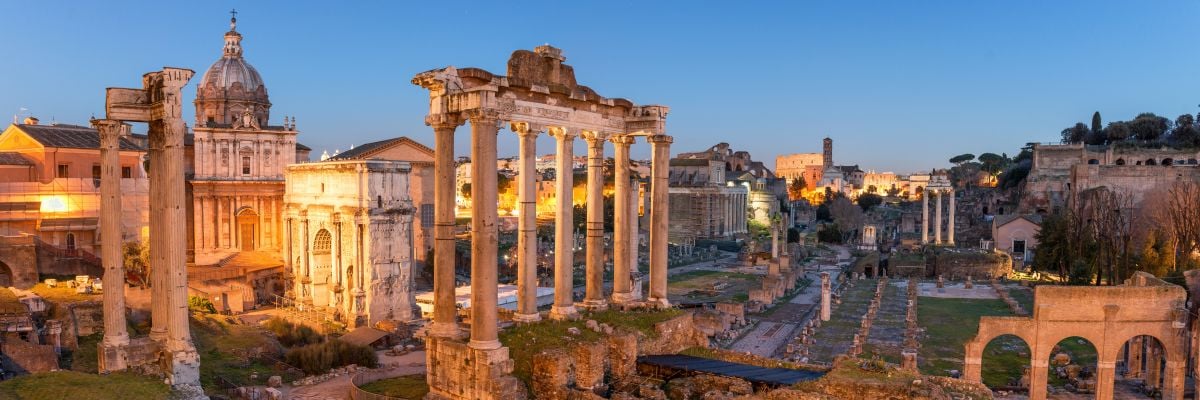
When the devastating news of the sack of Rome, the majestic and once-capital city of the Roman Empire, reached Jerome (342-420) in Bethlehem, he wept bitterly. Consternation gripped the irascible translator of Holy Scripture (and future saint) as he struggled to comprehend how an army of Visigoths, warriors who had recently fought on the side of Rome, could sack the historic city.
As news of the tragedy spread through the empire, it produced high emotions and theories as to why it happened. Some people saw in the destruction of Rome the end of the world; others searched for scapegoats. Although the Catholic Church had been legalized for a century and declared the official religion of the empire for thirty years, paganism remained the belief system for many Romans. And, as in previous centuries, many pagans blamed Christians for their misfortune.
The fall of the capital heightened the anger of these remaining pagans. They proclaimed that nothing so catastrophic happened to Rome when the empire worshiped the pagan gods. Indeed, in these pagans’ assessment, the empire flourished before embracing the Christian faith. St. Augustine (354-430) later addressed these criticisms in his influential work The City of God, but until then questions remained about the catastrophic attack, especially how and why it happened.
Romans had always been nervous about the various Germanic tribes on the borders, and that fear heightened early in the first century when Arminius (also known as Herman ‘the German’) annihilated three Roman legions at the Battle of Teutoburg Forest. Arminius was a chief of the Germanic Cherusci tribe who as a young boy spent time in Rome as a hostage to ensure peace between the tribe and the empire. Arminius served in the Roman Army and was granted citizenship and equestrian rank. He was sent to Germania to help the Romans subdue the unruly populace, but instead planned and implemented the defeat of the legions.
Arminius’s victory ended Roman plans for conquest east of the Rhine River, which became the natural border between the empire and the northern Germanic hordes. The Romans built forts and outposts along the Rhine, which later became major European cities, to control the Germans and guard the empire against invasion.
Over the centuries, Germanic tribes along the border grew restless and desired admittance into the empire in order to enjoy its economic, political, and military benefits. One such tribe, the Goths, appealed to Emperor Valens (r. 364–378) for permission to enter the empire in exchange for military service. Valens allowed some Goths entry, but local Roman commanders on the frontier treated them harshly, provoking a violent response in 377.
The Gothic rebellion prompted the emperor to marshal troops to the east in an effort to control the situation. Roman and Gothic troops engaged in combat at the Battle of Adrianople in 378, which resulted in one of the worst defeats of the Roman Army to a foreign foe. Nearly two-thirds of the Roman Army in the east was destroyed, including a significant number of experienced combat leaders and the emperor, whose body was never recovered. It was a disastrous defeat for Rome and shaped imperial fears of the “barbarians” for the next several decades.
Roman attitudes toward the Germanic tribes changed in the later fourth and early fifth century as the army turned to these warriors to provide much-needed manpower. The soldier shortage was so acute that by the end of the fourth century, only thirty years removed for the debacle at Adrianople, there were 20,000 Visigoths in the imperial army. Still wary of the Germanic peoples, the Romans usually treated their warriors as auxiliary troops attached to imperial units rather than as regular army units. This arrangement worked for a time until Alaric (d. 410), an ethnically Germanic commander of Goth auxiliary troops, demanded greater recognition for his troops’ courage and sacrifice and, failing to receive it, decided to march on Rome.
Alaric and his Goths fought for Emperor Theodosius the Great (r. 379-395) at the Battle of the Frigid River in 394. At the end of the first day of battle, Alaric was not happy. He had lost nearly half his men in the fighting and was upset that his forces were used in a manner that limited the risk to the regular Roman forces. Like other Germanic auxiliary commanders before him, Alaric desired a regular Roman military commission with the title Magister Militum (Master of Soldiers) in recognition of his service to Rome. When the emperor denied his request, Alaric left the army, became king of the Visigoths, and went east to raid. He remembered the emperor’s slight, however, and planned a return to the west.
Years later, Alaric returned at the head of a force of 30,000 troops and decided to make the Romans pay for their lack of respect. He tried several times to sack the city but was rebuffed. Eventually, he was on the cusp of victory when a delegation from the besieged city appeared in his camp asking for terms. Alaric told the delegates that he required all movable wealth in the city and the return of all Germanic slaves held in Rome. One of the ambassadors, aghast at the terms, asked Alaric what he intended to leave the Romans with. Alaric responded, “Your lives.”
The delegation returned to the city with Alaric’s terms, but the Senate countered with an offer of money, spices, and clothing. Alaric rejected the counteroffer and, on August 24, 410, unleashed his troops on the city where they rampaged, pillaged, and murdered for three days.
Interestingly, Alaric gave orders for his troops not to destroy churches or hurt the clergy in the city—orders they obeyed. The orderly sack of Rome by Alaric’s Visigoths brought great distress throughout the world. The city had not been sacked in 800 years, and its destruction caused pagans to blame the Church and the empire’s embrace of the Faith. Thankfully, St. Augustine thoroughly refuted those claims, but the sacking of Rome proved the harbinger of total imperial collapse in the west, which occurred in 476 when another ethnic Germanic warrior (Odoacer) declared himself king of Italy and deposed the last western Roman emperor (Romulus Augustulus).
Without Alaric’s sack, the Church wouldn’t have the brilliance of St. Augustine’s City of God. The sack was the harbinger of the decayed state of central Roman governing authority: by the end of the fifth century, it collapsed in the West, creating a political power vacuum that saw authority devolve to local Germanic chieftains. The Catholic Church stepped into that political vacuum and took a larger role in Western European politics, which maintained Western civilization in the centuries after the collapse of the Roman Empire.



